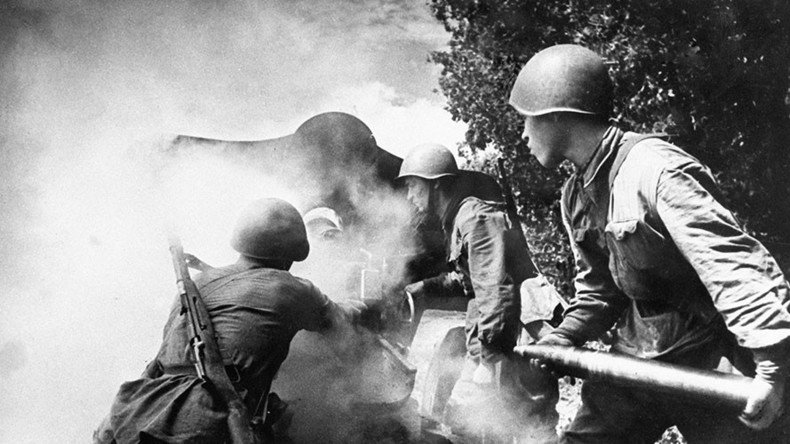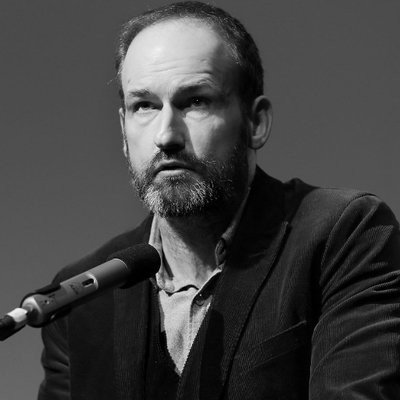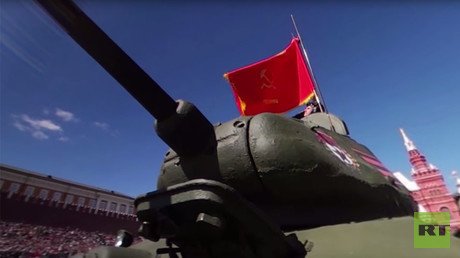The sacrifice of the Russian people in World War II must never be forgotten

The historic importance of the Soviet Union’s role in crushing fascism in the Second World War cannot be overstated. It is why the annual Victory Day commemoration, marked by Russians and friends of Russia all over the world on May 9, is so significant.
The epic sacrifice of the Russian-Soviet people in defeating Hitler’s Nazi war machine, a military force more powerful and seemingly invincible than any the world had seen hitherto, is still breathtaking over seven decades on.
As US historian Peter Kuznick writes: “Up to [D-Day, June 1944], the Soviet Union had almost singlehandedly battled the German military. Until the invasion of Normandy, the Red Army was regularly engaging more than two hundred enemy divisions while the Americans and British together rarely confronted more than ten. Germany lost over 6 million men on the eastern front and approximately 1 million on the western front and in the Mediterranean.”
In terms of casualties, around 419,000 Americans and 451,000 British people were killed in World War II. And though this is a sacrifice that deserves to be honored, when compared to the 26 million Soviets and Russians who perished it pales by comparison. That said, both Britain and the United States deserve huge credit for the tons of vital supplies, weapons, and materiel they contributed to the Soviet war effort, evidence that cooperation between the capitalist West and communist East was possible when faced with a genocidal enemy bent on slaughter and destruction.
Hitler’s war aims and Allied appeasement
In truth, Hitler never wanted a war with Britain or the United States. The fascist dictator was a staunch admirer of the British Empire; he was awed at the ability of this small maritime nation to control India, despite the subcontinent dwarfing it in size and population.
"I, as a man of Germanic blood, would, in spite of everything, rather see India under English rule than under any other,” Hitler wrote in ‘Mein Kampf’ (My Struggle), his infamous political manifesto. It should not be forgotten either that Hitler’s admiration for Britain was widely reciprocated in London, where pro-Nazi sentiment was endemic among the country’s elite, up to and including the royal family.
The British Empire was a model for Germany’s future expansion and colonization of Eastern Europe and Russia. Under Hitler’s perverse racial worldview, the Slav peoples, like the Jews, were ‘untermenschen’ (subhuman) whose land he coveted as ‘lebensraum’ (living space) for the German and Aryan race. Combined with his hatred of Bolshevism, his primary military and ideological objective was the destruction of ‘Judeo-Bolshevism.’
“The sacred mission of the German people [is] to assemble and preserve the most valuable racial elements…and raise them to the dominant position…All who are not of a good race are chaff.”
The invasion of the Soviet Union on June 21, 1941 did not take Stalin or the Soviet Union by surprise, as Western historians have erroneously claimed. Nor was the Soviet leadership under any illusions when it came to a future war with Germany. The Molotov-Ribbentrop Pact of 1939 was entered into by Moscow after attempts to forge a collective security alliance with Britain and France were rebuffed. With this in mind, Stalin had every reason to believe, especially after the Allies gave Czechoslovakia to Germany on a plate with the 1938 Munich Agreement, that London and Paris were eager to see Hitler attack Russia next. As Geoffrey Roberts writes, “Stalin did not believe that the British and French were serious about fighting Hitler; he feared, indeed, that they were manoeuvring to get him to do their fighting for them.”
The Molotov-Ribbentrop Pact bought Moscow invaluable time in which to arm and prepare for the war with Germany that the Soviets knew was certain. However, Stalin believed it would not take place until the spring of 1942, given that Hitler was now at war with Britain after his invasion of Poland, and given that the Nazi dictator had long railed against repeating Germany’s mistake of becoming embroiled in a war on two fronts, as it had in World War I.
Ride #VDay military hardware through Moscow with 360 VIDEOS https://t.co/zS9G6S536mpic.twitter.com/c23PV5wnLK
— RT (@RT_com) May 9, 2017
Operation Barbarossa and Stalin’s leadership
The initial success of Operation Barbarossa, the Nazi invasion of the Soviet Union, was astounding, involving huge encirclements and the destruction of Red Army divisions and formations deployed close to Russia’s western borders. Hitler and his generals had planned for a short and ferocious war against what they believed was a badly organized and led Red Army, and in those first few weeks it was an analysis that appeared to be accurate. “The German Wehrmacht must be prepared to defeat Soviet Russia in one rapid campaign,” Hitler set out in a military directive. “The mass of the [Red] army stationed in Western Russia is to be destroyed in bold operations involving deep and rapid penetrations by panzer spearheads, and the withdrawal of combat-capable elements into the vast Russian interior is to be prevented.”
Most Western observers did not believe that the Soviet Union would recover from its initial losses. Indeed, it seemed by the end of November 1941 that the fall of Moscow was imminent, as the Germans approached to within view of the Kremlin’s spires.
Here the role of Stalin’s leadership came to the fore. First, he took the decisive gamble to redeploy nine divisions from the Far East and Russia’s contested border with Japan, deciding that the Japanese would no longer attempt to invade, having mounted an attack on the United States and British forces in the Pacific instead. Second, he appointed General Zhukov to organize the defense of Moscow. Third, and most importantly, despite ordering an evacuation of the city by government departments, Stalin chose to remain, thus inspiring the troops and Moscow’s citizens with the determination to repel the enemy come what may.
What followed is legendary. The Soviet counteroffensive at the gates of Moscow began on December 5, 1941, with Stalin reviewing Red Army troops as they marched through Red Square on their way to the battle as part of that year’s annual commemoration of the Russian Revolution on November 7.
#Putin says #WW2 started due to disunity of world’s leading countries, calls on world to unite https://t.co/trnAlLaURO
— RT (@RT_com) May 9, 2017
Remarkable endurance and achievement
The Battle of Moscow was the first of many epic battles that now belong to legend. It was followed by the Battle of Stalingrad (August 23, 1942–February 2, 1943); the Siege of Leningrad (September 8, 1941–January 27, 1944); the Battle of Kursk (July 5, 1942–August 23, 1943): Operation Bagration (June 22–August 19, 1944); and the Battle of Berlin (April 16–May 2, 1945).
One man who understood the Red Army’s role in crushing the fascist juggernaut was Britain’s wartime leader Winston Churchill. In a speech to the House of Commons in August 1944, he observed: “It is the Russian armies who have done the main work in tearing the guts out of the Germany army. In the air and on the oceans we could maintain our place, but there was no force in the world which could have been called into being … that would have been able to maul and break the Germany army unless it had been subjected to the terrible slaughter and manhandling that has fallen to it through the strength of the Russian Soviet armies.”
No people have endured what the Russian people endured between 1941 and 1945. And no other people have achieved what they achieved in liberating Europe from the tyranny of fascism.
The statements, views and opinions expressed in this column are solely those of the author and do not necessarily represent those of RT.















